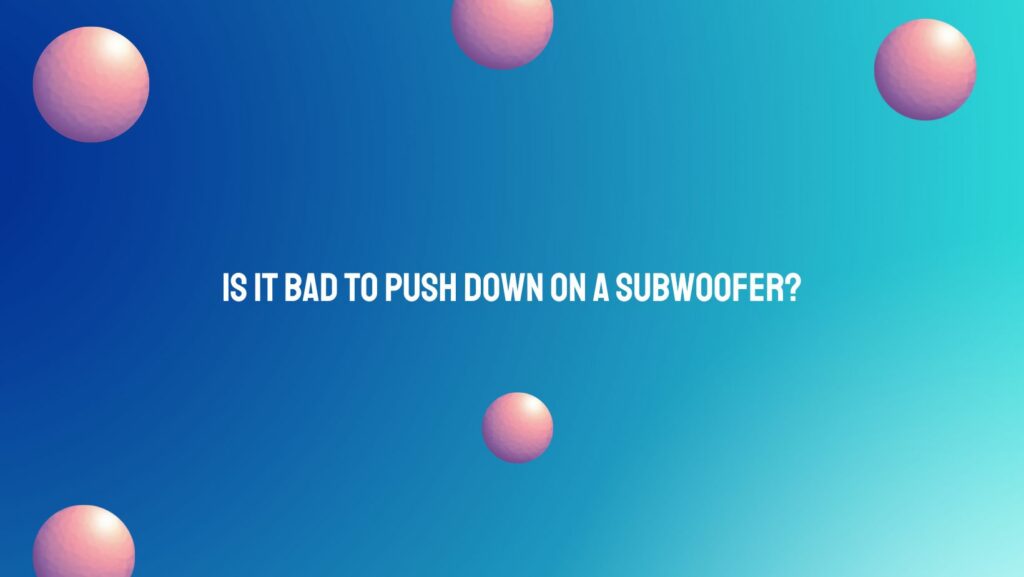Subwoofers are a vital component of many audio systems, providing deep bass frequencies that can enhance your music and movie-watching experience. These speakers are designed to handle low-frequency sounds, and they’re built to withstand the vibrations and air pressure changes that come with playing bass-heavy content. However, the question of whether it’s bad to push down on a subwoofer is one that often arises among audio enthusiasts. In this article, we’ll explore this topic and provide insights into the potential consequences of pushing down on a subwoofer.
Understanding Subwoofers
Before delving into the issue of pushing down on a subwoofer, it’s essential to understand the basic principles of how subwoofers work. Subwoofers are specialized loudspeakers designed to reproduce low-frequency audio signals, typically in the range of 20 Hz to 200 Hz or even lower. These frequencies are felt more than they are heard and can add a rich, immersive quality to music and movie audio.
Subwoofers have large diaphragms that move in and out rapidly to create the deep bass sounds. They also have powerful magnets and coils, which are crucial for their ability to handle high power levels. The combination of these components allows subwoofers to produce the low-frequency vibrations that we associate with thumping bass.
Pushing Down on a Subwoofer: The Concerns
The concern about pushing down on a subwoofer arises from the idea that physically pressing on the subwoofer cone may damage the speaker. The subwoofer cone is a critical part of the sub’s operation, responsible for moving air and producing sound. When you push down on the cone, it can create a range of potential problems:
- Tearing the Cone: Subwoofer cones are typically made of lightweight materials such as paper, polypropylene, or composite materials. Applying force to the cone can cause it to tear or develop creases, which can negatively impact the subwoofer’s ability to produce sound.
- Displacement of the Voice Coil: Pushing down on the cone can cause the voice coil (the coil of wire inside the subwoofer’s magnetic field) to become misaligned or move out of its intended position. This can result in scraping or rubbing against the coil, leading to distortion and damage over time.
- Suspension Damage: The suspension system (often composed of a surround and spider) that supports the subwoofer cone can be adversely affected by excessive pressure. Damage to the suspension can lead to a loss of control over the cone’s movement and ultimately affect the subwoofer’s performance.
- Reduced Sound Quality: Any of the above issues can result in a reduction in sound quality, causing distortion, loss of efficiency, or even complete failure of the subwoofer.
The Right Way to Interact with Your Subwoofer
While it’s generally not advisable to push down on a subwoofer cone, there are more appropriate ways to interact with your subwoofer:
- Handle with Care: When installing or moving your subwoofer, handle it carefully to avoid any damage to the cone, suspension, or other components.
- Avoid Overexcursion: Ensure that your subwoofer isn’t subjected to signals that cause it to move excessively. High excursion levels can potentially damage the subwoofer, so always use appropriate settings and filters to prevent this.
- Use a Grille: If you’re concerned about physical damage to your subwoofer, you can use a grille to protect the cone from accidental contact.
- Regular Maintenance: Periodically inspect your subwoofer for any visible damage or irregularities. This can help you catch potential issues before they worsen.
In Conclusion
Is it bad to push down on a subwoofer? In short, yes. Pushing down on the cone of a subwoofer can cause physical damage that adversely affects the speaker’s performance. Subwoofers are precision-engineered devices designed to reproduce low-frequency audio faithfully, and mishandling can result in reduced sound quality, distortion, and even permanent damage. It’s crucial to treat your subwoofer with care and follow proper installation and usage guidelines to ensure it operates optimally and delivers the powerful bass experience you desire.


